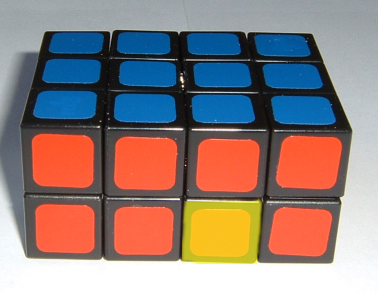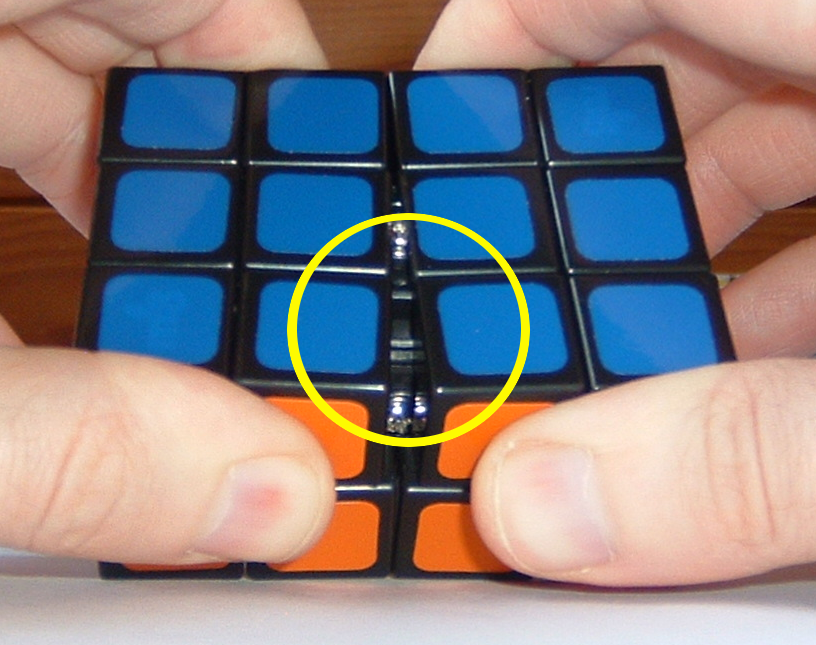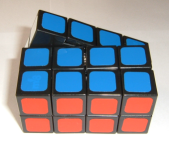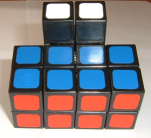
Terminology:
* by an "edge" I will mean the hidden inner edges of the 3x3x3-ish mechanism in the centre of the puzzle.
* by an "end" I will mean the 2x1x1 pair of cubes in a corner, such as the LF ("left-front") end here:

By my understanding of the puzzle, one of the outer pieces of the cube is fixed to part of the core, and we are trying to find that piece. So you should only have to do the fiddly screw tests below once.
1. Hold the puzzle so that the upper face is a 3x4 face, the left face is a 2x3 face, and therefore the front face is a 2x4 face:

2. Start rotating the left-hand two layers a bit, and observe the screw visible in the middle of the upper face. It will either stay in place with the right-hand layers, which is good:

or it will move with the left-hand layers, which is bad:

If it's bad, then rotate the whole puzzle 180 degrees about the vertical axis, so that the behaviour is good. The fixed piece will now be in the right-hand half of the puzzle.
3. Now hold the cube in the correct position after step 2 and rotate the back layer 180 degrees. Then apply the left-layers test as in step 2, and as in step 2 you want the screw to stay with the right-hand layers. In the following picture, you can see bad behaviour here:

Undo that back layer rotation. If there was bad behaviour, rotate the whole puzzle about the left-right horizontal axis. To be clear: suppose the puzzle is in the orientation in the first picture on this page (so blue on top, red at the front); then the intended rotation would leave blue on the bottom and red at the back. The fixed piece will now be on the bottom layer.
In this orientation, make a note of which piece is in the following position:

This is the fixed piece, and in future to get the orientation correct, simply hold the puzzle with this piece in this position. (Obviously, there's no reason for it to be the red+green piece.)
1. If a 2x3 face doesn't rotate, are both ends blocked or just one? It should be obvious whether an end is blocked or not -- if it's not blocked then it should be free to move a bit until the other end stops it, while if it is blocked then it won't move at all. Try this with the 2x3 faces and find the blocked ends.
I find the following freedoms of movement. An unblocked end, which wobbles fairly freely:

A blocked end, which barely moves:

Note. I believe that it is impossible get the end in the RF ("right-front") position blocked, and below I shall assume that this is the case.
By this assumption, the bad ends will be some of LF, LB, RB.
To look inside, hold the puzzle in the standard orientation above with thumbs along the UF edge, and gently pull it apart at the middle along that edge. Inside, we can see the upper-face screw (the one we used for orientation earlier) and now also the front-face screw. Those screws correspond to the centres of the inner 3x3x3 we're pretending to use. Between those two screws we see an edge of this hidden 3x3x3.
The bad edges look like a fairly smooth recess:

The good edges look more hollow, with a small hole:

Note. As with the previous note, I believe that it is impossible to get the hidden edge in the DF ("down-front") position to be a good edge, and I shall assume this.
By the assumption above, the good hidden edges will be some of UF, UB, DB.
These are all formed by conjugations based on the "sixer trick" idea, that is the sequence (L2 U2)3 for the regular 3x3x3 cube. I wrote it in such terms at first, most of which remains here. I personally find doing it as described there easier. But here are just the move sequences
For legibility in the table below, since all such moves will be by 180 degrees:
* U will mean "turn the upper half by 180 degrees" (note: upper half).
* L will mean "turn the left half by 180 degrees" (note: left half).
* B will mean "turn the back layer by 180 degrees".
* Lastly, S will mean the following sequence: turn the back face 90 degrees, do (L U L U L U), then undo that back face rotation. (Remember that L and U here are 180-degree rotations.) The initial 90-degree rotation is anticlockwise when looking directly at the back face, or equivalently clockwise when looking at the puzzle as in the first picture on this page:




Here are some (probably highly non-optimal) move sequences. (Note that if you just want to unblock and don't care about the external patterns, then many of these can be truncated. E.g., move 10 could be just (L B L B L B) S. The moves below preserve the external pattern.)
| Bad ends | Good edges | Solution | |
| 1 | LF | UF | L (U S U S) L |
| 2 | LF | UB | L (S U S U) L |
| 3 | LF | DB | B L (S U S U) L B |
| 4 | LB | UF | U S U S |
| 5 | LB | UB | S U S U |
| 6 | LB | DB | L B L (S U S U) L B L |
| 7 | RB | UF | B (U S U S) B |
| 8 | RB | UB | U B (U S U S) B U |
| 9 | RB | DB | B (S U S U) B |
| 10 | LF + LB | UF + UB | (L B L B L B) S (L B L B L B) |
| 11 | LF + LB | UF + DB | S |
| 12 | LF + LB | UB + DB | U S U |
| 13 | LF + RB | UF + UB | B S B |
| 14 | LF + RB | UF + DB | (L B L B L) S (L B L B L) |
| 15 | LF + RB | UB + DB | (B U) S (U B) |
| 16 | LB + RB | UF + UB | (L B) S (B L) |
| 17 | LB + RB | UF + DB | (B L B L) S (L B L B) |
| 18 | LB + RB | UB + DB | (L B U) S (U B L) |
| 19 | LF + LB + RB | UF + UB + DB | S, then do line 8 |